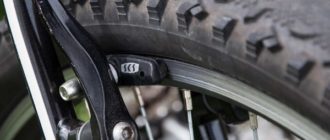There are a lot of positive things about riding a bicycle. But, no matter how you look at it, it’s an injury-prone activity. One of the reasons is bad roads. Even if you ride quietly, it happens that the chain falls off, let alone jumps or rapid descents. Firstly, it is unpleasant – you have to brake and correct the chain. Secondly, it is dangerous, because you can lose control: you can injure yourself and break your bike. Why do we need a bicycle chain restraint, how it makes riding safe, and whether it is possible to make it with your own hands, you will learn below.
The construction
The chain is a part of the transmission. To protect the chain from falling off the sprocket uses a special device – a bicycle chain stabilizer. It prevents the bike chain from coming off, protects it from damage, and helps keep it in a stable working position. Bicycle enthusiasts refer to this device as a “soother” or “changed”.
It is not a single item, but a set of elements placed on the frame. There are several types of “calipers” on the bicycle market, differing mainly in the type of attachment and functionality.
Initially, the design consisted of a rokring and two rollers, which were installed on the frame in place of the front derailleur. But science does not stand still. Rockrings are getting smaller and rollers are being replaced by frames. This makes the weight of the construction less and the construction cheaper.
Using a Rockring
A rockring is an element made to protect the front sprocket from all kinds of impacts and to keep any debris out. And do you know what else a bike chain stabilizer or bike rokring is for? It prevents clothes from getting “chewed up” while riding. In fact, a rockring is not really a bike chain restraint, because it is also installed separately. A rockring is a circle larger in diameter than a bicycle sprocket.
Rockrings are made of metal or plastic. There is a “banana” design that is a simplified version that is not a whole circle, but only a part. This reduces the weight of the stilling device and at the same time makes certain places protected. It is essentially no different than a rocker.
The use of casters and frames
In essence, the “soothing” component is the roller that supports the chain. There are such variations of roller calming:
- With one roller – this is enough to provide reliable protection.
- With two small rollers – mounted on a special bar, and the entire structure is attached to the carriage unit.
- with large rollers – installed on the front sprockets of speed bikes;
In addition, there are variants without rollers, when the chain is held by a frame – this option is lighter in weight and easier to work.
Cassette Calming.
It’s a special story to install a soothsayer in the back. Professionals don’t do this, but you often see similar cassette designs on ordinary bikes. They are a roller (sometimes a frame). These bicycle chain stabilizers are attached to the pedal. They can be at the top or bottom and do not come in contact with the sprockets in any way. Such designs hold the chain securely under all circumstances. The disadvantages include problematic gear shifting. But this is compensated for by the ease of manufacture and low cost.
Mounting methods
An important point is how you install the chain stabilizer on the bike. If installed incorrectly, you will not achieve high efficiency. There are four basic types of bike chain restraint installation.
- BB – Mounted on the carriage, the stiller is pressed against the frame. Used with “bananas” and other partial guards.
- ISCG – usually the mount is on the frame, if there are no ISCG mounts for the soothsayer, an adapter is included, mounted to the frame in three places, considered obsolete.
- Standard ISCG 05 – mounting appeared not so long ago, is the most progressive and at the moment is supported by the leading brands, in this variant diameter of circle has changed from 60 to 73 mm and the distance between bolts has changed from 48 to 56 mm.
- D-Type, E-Type, and others – mounted instead of the front derailleur, this variant is considered obsolete at this time.
For installation should spend about half an hour. You need the following tools: hexes, crank extractor, carriage remover, thread locker, wrench, etc.
Can you make it with your own hands?
You don’t have to buy a rocker’s arm, you can make one yourself. There are a lot of illustrative diagrams on the Internet to make the rokring and fasteners yourself. And as for the pen mounts, the models made by yourself come out even better than the purchased ones. Masters, armed with a drill and a jigsaw, assemble very decent options that cope with the main function of the device and do not let the chain fly off. A simple to make, but effective soothsayer is made from a light reflector.
Most often mastered:
- Rockring (partial or full) with a BB mount.
- ISCG mount with frames. Made by hand, not using metalworking.
- Rollers for the front (rear) sprocket with a partial mount.
- Frames to protect the chain.
Buying advice
Today, not only professional athletes but also amateur bicyclists install chain slackers on bikes. What a chain restraint is for is clear to everyone, but how to choose it correctly? Usually, the chain slacker is chosen taking into account the size of the drive sprocket, the features of the frame, and individual preferences. The cost of these accessories varies greatly. Someone chooses plastic models from China for a thousand rubles, and someone – a quality set of recognized brands for hundreds of dollars.
Today’s bike market is difficult to call a variety. But you can find global manufacturers if you want to:
- Brand Truvativ. Produces high-quality products, and is the undisputed leader for many years.
- Company Hope. This brand is from the UK and uses only newfangled materials.
- Funn. Another British firm, which can be found in Russia not so often and the price is often unreasonably overpriced.
- The middle segment in terms of price ranks the firm Shimano.
The products of these firms are known to athletes and cycling enthusiasts, but their goods will have to lay out a pretty penny.
Brakes for the most part are designed for two stars, in rare cases for three. In addition, it is worth looking at the number of teeth on the stars, this also affects the choice of soothing. On the basis of the material, the soothers are divided into:
- Plastic (weighs little, inexpensive, but fragile);
- Metal (mainly made of aluminum, they are heavier than plastic, cost higher, but are more durable);
- Carbon fiber (not as durable as the ones made of metal, they are more expensive, but weigh less).
It is recommended to choose a lighter stabilizer for those who like fast riding. Those who ride off-road or like to perform tricks should opt for a sturdy soothsayer.
Rockrings are needed not only for those who are into extreme riding, but also for all other cyclists. There are sedges without rockrings, but with star protection. In addition, there are soothers without rockrings and protection. These options are the lightest, consisting of a frame and 1-2 rollers. Their disadvantage is that the star is open to impact.
If you have no desire to spend money, it is realistic to make a soothsayer yourself. Homemade devices are not inferior to the purchased ones, they cope well with their purpose.
Conclusion
Now that you know why you need a chain stabilizer on a bicycle, then be sure to take care of its availability. The chain restraint keeps the chain from falling off the sprocket and protects it from all kinds of damage, thereby contributing to a safe ride. Selecting and installing a chain restraint is an important step that should be taken responsibly.









